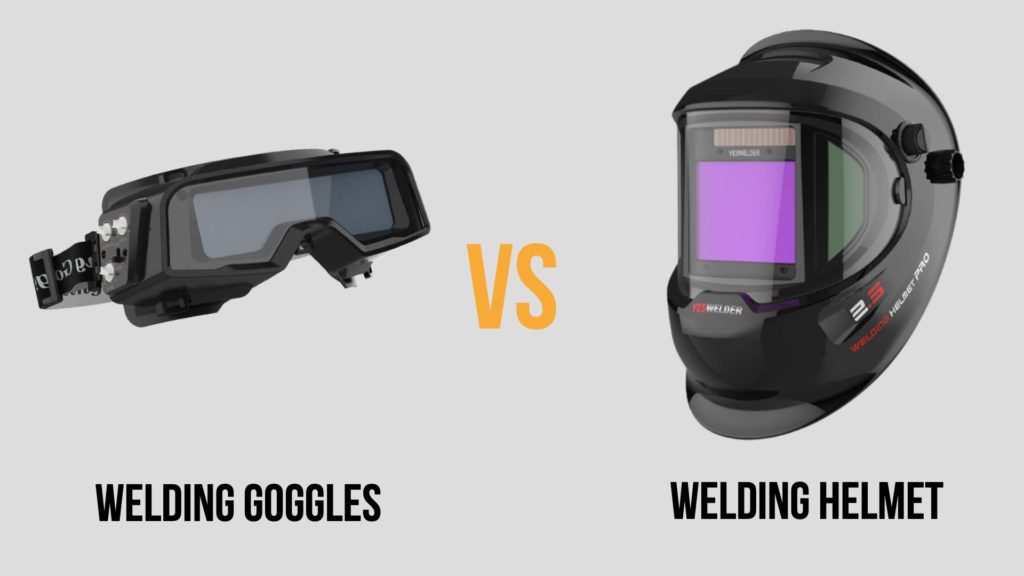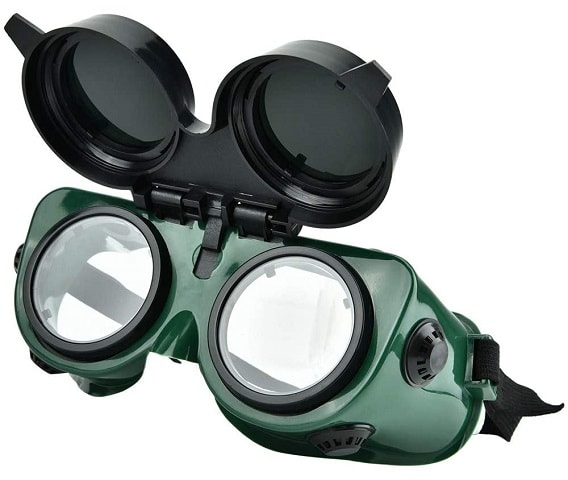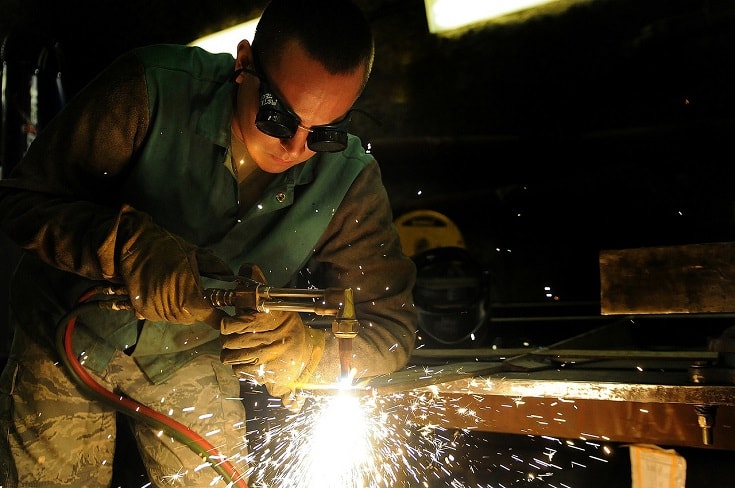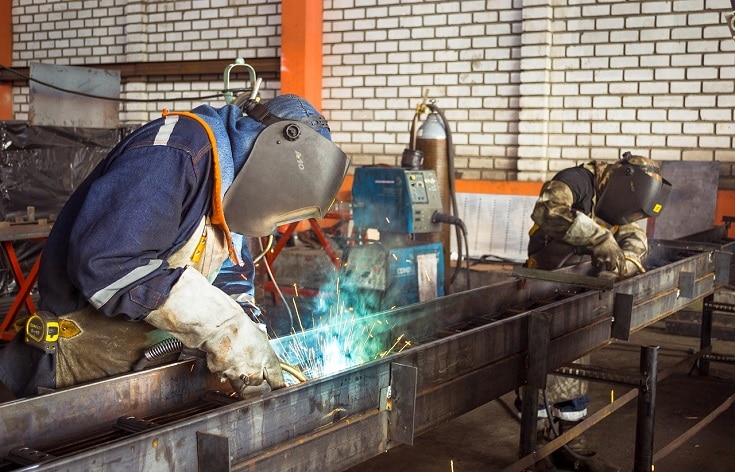Welding Goggles vs Helmet: Which to Choose?
Last Updated on

Whether you are a professional welder or not, you need protection against harmful UV light, heat, sparks, and radiation that could damage your eyes and skin while welding. There are two options on the table: goggles and helmet. Each has its advantages and shortcomings.
While goggles are lighter and less cumbersome, they only offer protection for the eyes. Helmets will protect your eyes and the rest of your face, but they are bulkier and more confining. If you are wondering which of these options to choose, you have come to the right place. This article will outline their differences in detail.
Goggles Overview
Welding goggles are similar to glasses but thicker and tougher. They come with filters that temper the glare without limiting your vision. And they are specially designed to prevent potentially harmful elements from reaching the corneas.
Never make the mistake of thinking you could withstand the intense light with your naked eye. Even if that were possible (it is not), you still need to protect your eyes from the unseen optical radiation. When left unprotected, eyes could develop photokeratitis, a painful condition that could take up to 48 hours to clear. In the worst-case scenario, you could even go blind.
If the protective equipment weighs you down when welding, wearing goggles is the minimum protection you can’t do without. They will shield your eyes without being cumbersome or stifling.

Level of Protection
The intense UV light, sparks, heat, radiation, and other debris can injure or permanently damage your eyes if you leave them exposed. Wearing goggles shields your eyes from the elements without hindering your visibility. But they need to fit properly if they are to provide adequate protection.
The right fit should extend from the eyebrows to the cheekbone, and it should cover both the front and the side of your eyes. Remember, the particles can come from any direction and not just the front. So, consider options with wrap-around frames or side shields.
Although goggles provide adequate protection for your eyes, the rest of your face is still exposed to heat and radiation. Continued exposure can produce symptoms that resemble a sunburn. In extreme situations, you could develop skin cancer.
Visibility
Although goggles have filters that block the intense UV rays from reaching your eyes, the lenses are clear enough. As a result, visibility is never a problem. You can see the results of your work clearly while still protecting your eyes from damage. Even people who wear glasses can see through goggles.
Darker shades will not offer the same level of visibility as lighter shades. Ultimately, what you choose will depend on the type of welding application. But if you are not sure, refer to the Occupational Safety and Health Administration (OSHA) regulation 1910.133 for a guide on which filters to use based on the operation.

Level of Convenience
Many welders prefer goggles because they are light and less cumbersome. Since they only cover the eyes, you never feel confined or restrained. You can move your head about as you like, and your visibility is not limited in any way. Of course, this freedom comes at the expense of exposing the rest of your face to the intense UV light, heat, and radiation. Whether the freedom is worth the risk boils down to personal choice.
- They are less cumbersome
- They are light
- They don’t limit visibility
- They only protect the eyes
Helmets Overview
If you want the ultimate protection for your face and neck, buying a helmet is the way to go. Apart from shielding your delicate eyes from the elements, it also protects the rest of your face and neck. Without it, you would have to deal with skin problems, the worst of which is skin cancer.
Helmets have come a long way. Earlier versions had visibility problems, and users complained of not seeing through the lens clearly. Today it is easier to change the lens to a shade that will offer the utmost protection without hindering visibility. Of course, what shade you choose will depend on the nature of the welding you do.
Thanks to new LCD technology, now helmets have auto-darkening properties. And they can automatically darken to a shade that will offer you the best protection. That is quite a leap from earlier days when you had to flip the permanently-darkened glass manually to see. However, helmets don’t offer the same freedom as goggles.

Level of Protection
Compared to goggles, helmets offer better protection. They protect the entire face from exposure to excess UV light, optical radiation, heat, sparks, and other debris. You never have to deal with photokeratitis, blindness, or skin cancer. You should also wear gloves, cuffless pants, a fireproof jacket, rubber-soled shoes, and earplugs for full-body protection.
Ensure the helmet meets standards set by the American National Standards Institute to guarantee protection from all harmful elements. Compliant helmets will protect your eyes regardless of the shade settings. Additionally, auto-darkening helmets allow you to increase or lower their sensitivity. You can vary the amount of light required to switch to a darker shade.
Visibility
Helmets have evolved over the years. Today you can switch to a shade of your choosing depending on the type of application. But it is the auto-darkening feature that changed the game. Thanks to the technology, helmets can automatically switch to a darker shade after the light exceeds a specified level. Therefore, you no longer need to strain your neck while trying to flip open or close the visor.
Level of Convenience
Although helmets will provide the best possible face protection, they are not the most comfortable of gear to wear. Compared to goggles, they are rather heavy and bulky. If you plan to weld for many hours, you are likely to experience fatigue.
Moreover, helmets can be confining and stifling. If you are not used to it, it is easy to feel suffocated. Some people would opt for goggles based on this sole reason. It is a choice between convenience and safety. You can either risk exposing your face to heat and radiation or forego the freedom that only googles can offer.

- Protects the entire face
- Some have auto-darkening features
- Protects the neck
- Bulky
- Confining
Which is Right for You? Welding Goggles vs Helmet
Both goggles and helmets have advantages and disadvantages. But a helmet will offer you better protection since it covers the entire face plus the neck. The auto-darkening feature also improves ease of use. However, helmets tend to be heavy, bulky, and confining. In contrast, goggles are so light that it is easy to forget you have them on. But although they offer the most freedom during use, they only protect the eyes.
If you are only content with protecting the most sensitive part of the face, goggles will be a perfect choice. They offer optimal visibility, and their lightweight nature makes them easier to work with. However, a helmet is the right option for you if you prioritize safety over everything else. It will shield your entire face and neck from harmful elements such as excess UV light.
Final Thoughts
In a fair contest between goggles and a helmet, the helmet wins, fair and square. Granted, everybody loves the freedom that comes with using goggles. Their lightweight nature means you can leave them on for as long as you like, and visibility is never a problem. However, nothing beats the level of protection that comes with wearing a helmet when welding. Not only are your eyes protected, but so is the rest of your face and neck. When choosing a welding helmet, go for the lighter options to prevent strains and injuries on your neck.
Featured Image: Left: Welding Goggles (Source: YESWELDER True Color Auto Darkening Welding Goggles, Amazon), Right: Welding Helmet (Source: YESWELDER Large Viewing Solar Powered Auto Darkening Welding Helmet, Amazon)
